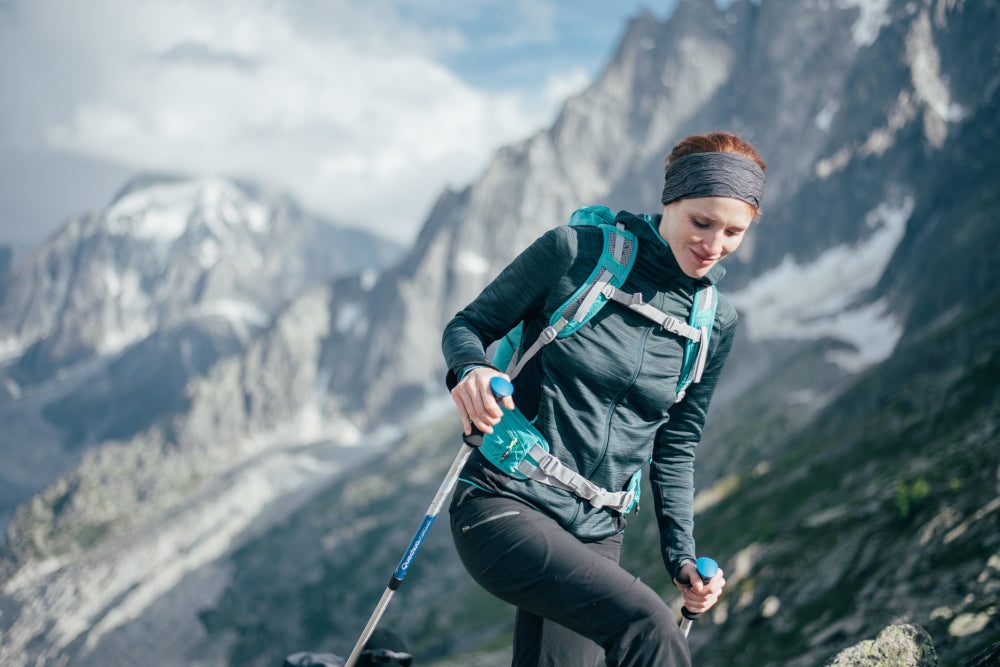
10 Stretches For Hikers
Share
Stretching shouldn’t be painful. Remember to move gradually and gently, and on a mat if you're indoors. And don’t forget to breathe deeply and relax. If in the slightest doubt or pain, consult your doctor.
It's also good to remember, stretch right after your hike, don't wait! If you stretch long after a physical effort, you might hurt yourself. And always adapt your stretching to your body and to your physical condition: listen to your body.
Tip: to make sure you don’t forget anything, begin by stretching your upper body and gradually move downwards to end with your feet.
The Upper Body
The Neck
In a standing position, look straight ahead of you while relaxing your neck and with your arms against your body. Tilt your head to the right, place your right hand on your left ear and pull your head gently towards your right shoulder for about 30 seconds. Repeat on the other side.

The Shoulders
In a standing position, place your left hand on your right shoulder. Then hold your left elbow with your right hand. Pull it slowly towards you, without straining. Your left elbow should move closer to your right shoulder, then hold for about 30 seconds. Repeat on the other side. Remember to breathe deeply.

The Arms
You will use your arms a lot if you have hiking poles, so don’t forget to stretch them first. Read our article here to find out why poles are so useful, and this article to find out how to adjust them.
For the biceps: stand and stretch one arm forwards, parallel to the ground, the palm facing upwards and bending your fingers towards the floor. Hold this palm with your other hand and pull your fingers gently back towards you.
For the triceps: in a standing position, place your right-hand flat with your palm between your shoulder blades and pull your right elbow gently and gradually down with your left hand. You can tilt your upper body to the left to accentuate the position. Hold for about 30 seconds. Repeat on the other side.

The Back
Stand and raise your arms in the air while breathing in, join your hands with the palms facing up. Push up as you exhale. Gently release your arms and repeat the exercise.

The Lower Body
The Waist
Stand with your knees slightly bent, place your left hand on your waist and raise your right hand in the air, arm held straight, with your palm facing upwards. Tilt slightly to the left while pulling on the arm in the air. Hold for about 10 seconds, then repeat on the other side.

The Glutes
Look for a tree or a solid post. Test to see if the object can withstand your weight before starting. Hold the tree or post with your left hand and place your left foot on your right knee. Bend the right knee as if you were sitting down on an invisible chair. Be careful to keep your right foot flat on the ground. Hold for 30 seconds then switch legs.

The Adductors
Standing with your legs apart at a distance of twice the width of your shoulders, put your hands on your hips and bend your left leg. Keep your right leg perfectly straight. Hold for 20 to 30 seconds. Then switch legs.

The Thighs
For the quadriceps: stand and place your left hand on a tree, post or wall for greater stability. Move your right foot up towards your bottom and hold your ankle with your right hand. Pull gently until you feel your muscle stretching at the front of your thigh. Make sure you keep your back straight. Your two knees must remain side by side. Hold for 20 to 30 seconds then switch legs.
For the hamstrings: stand with your feet apart, at a distance slightly wider than the width of your shoulders, and cross your hands behind your back. Move your shoulder blades closer together and lean your upper body forward, keeping your back straight. You can bend your knees slightly. Hold for about 30 seconds. Return gently to your initial position.

The Calves
The calves come under a lot of stress when climbing, and are often subject to cramp. Do not hesitate to stop and stretch your muscles both during your hike and on returning. Lean against a tree or wall and move into a lunge position, with the front leg bent and the back leg straight. Move your weight over the front leg. Make sure you keep the heel of your back leg on the ground. Hold for 20 to 30 seconds then switch legs.

The Ankles
Like for the calves, lean against a tree or wall and move into a lunge position, with your front leg bent and your back leg straight. Bend your back leg while tilting your hips backwards to move them over your heel. Your front leg then becomes straight. Hold for 20 to 30 seconds then switch legs.

Your body will thank you for taking care of your muscles and tendons. Do stretching exercises regularly to prevent chronic injuries and avoid feeling sore in the days following your hike!















